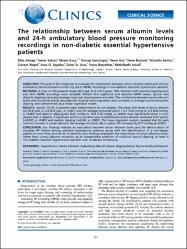The relationship between serum albumin levels and 24-h ambulatory blood pressure monitoring recordings in non-diabetic essential hypertensive patients

Göster/
Erişim
info:eu-repo/semantics/openAccessTarih
2016Yazar
Ahbap, ElbisŞakacı, Tamer
Kara, Ekrem
Sahutoğlu, Tuncay
Koç, Yener
Baştürk, Taner
Sevinç, Mustafa
Akgöl, Cüneyt
Kayalar, Arzu O.
Uçar, Zuhal A.
Bayraktar, Feyza
Ünsal, Abdulkadir
Üst veri
Tüm öğe kaydını gösterKünye
Ahbap, E., Sakaci, T., Kara, E., Sahutoglu, T., Koc, Y., Basturk, T., Sevinc, M., Akgol, C., Kayalar, A. O., Ucar, Z. A., Bayraktar, F., & Unsal, A. (2016). The relationship between serum albumin levels and 24-h ambulatory blood pressure monitoring recordings in non-diabetic essential hypertensive patients. Clinics (Sao Paulo, Brazil), 71(5), 257–263. https://doi.org/10.6061/clinics/2016(05)03Özet
OBJECTIVES: the goal of this study was to evaluate the relationship between serum albumin levels and 24-hour ambulatory blood pressure monitoring (24-h ABPM) recordings in non-diabetic essential hypertensive patients. METHODS: A total of 354 patients (mean [SD] age: 55.5 [14.3] years, 50% females) with essential hypertension and 24-h ABPM recordings were included. Patient 24-h nighttime and daytime ABPM values, systolic and diastolic dipping status and average nocturnal dipping were recorded. the correlations between serum albumin levels and nocturnal systolic and diastolic dipping were evaluated, and correlates of average nocturnal systolic dipping were determined via a linear regression model. RESULTS: Overall, 73.2% of patients were determined to be non-dippers. the mean (SD) levels of serum albumin (4.2 [0.3] g/dL vs. 4.4 [0.4] g/dL, p<0.001) and the average nocturnal systolic (15.2 [4.8] mmHg vs. 0.3 [6.6] mmHg, p<0.001) and diastolic dipping (4.2 [8.6] mmHg vs. 18.9 [7.0] mmHg, p<0.001) were significantly lower in non-dippers than in dippers. A significant positive correlation was noted between serum albumin levels and both systolic (r=0.297, p<0.001) and diastolic dipping (r=0.265, p<0.001). the linear regression analysis revealed that for each one-unit increase in serum albumin, the average nocturnal dip in systolic BP increased by 0.17 mmHg (p=0.033). CONCLUSION: Our findings indicate an association between serum albumin levels and the deterioration of circadian BP rhythm among essential hypertensive patients along with the identification of a non-dipper pattern in more than two-thirds of patients. Our findings emphasize the importance of serum albumin levels, rather than urinary albumin excretion, as an independent predictor of nocturnal systolic dipping, at least in non-diabetic essential hypertensive patients with moderate proteinuria.

















